
Roller coasters, & ball runs with K'Nex
- Introduction
- Focus questions
- Procedure related to concepts of:
Introduction
This page includes sample investigations with coasters and ball runs. While K'Nex are the construction materials for most of the examples other materials may be substituted. For clarification I refer to any track that completes a circle as a coaster and one that does not as a ramp. Also there are two kinds of vehicles. One where the wheels ride on top of a ramp and a coaster vehicle with two sets of wheels so one wheel rides above and the other below the rail, with the rail in between.
Many kinds of investigations can be made to explore the science of coasters and ball runs, as well as team building and cooperative learning activities with K'Nex. In these activitied learners may use K'Nex to building coasters or runs and explore differerent variables to discover how they affect the motion or ride. Concepts can include:
- Energy, conservation, potential energy, kenetic energy
- Motion, speed, slope, mass, and friction, and Newton's Laws of Motion
- Design process
- Social skills and cooperative learning
May use K'Nex ® to create a down hill ramp, ball run or a circular run (coaster) to explore motion, force, and mass. Create a ramp; roller coaster; or ball, marble, or sphere run; where an object (marble or vehicle) will travel the entire track. Samples ...
The K'Nex ® set Down hill thrill includes a track with a jump and one with four drops the Devil's Drop course. The hill below was used for most investigations with the jump removed and more track added for a horizontal run.
Coasters
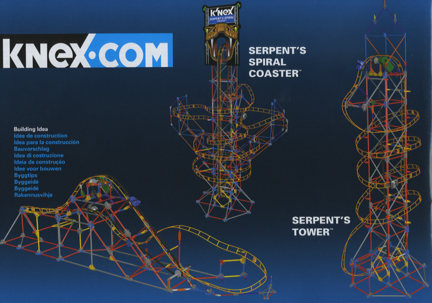
More designs
Coaster with loop
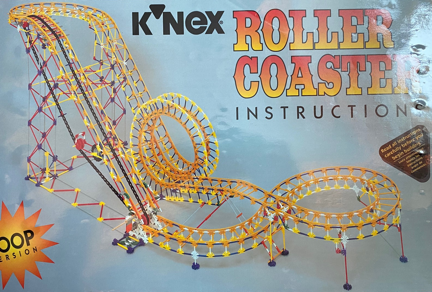
Coaster with loop
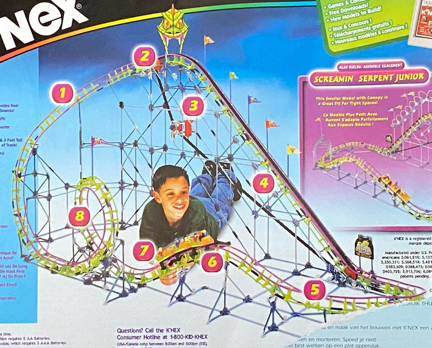
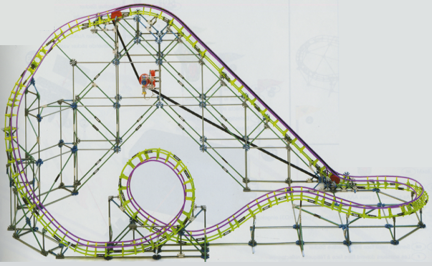
Coaster straight run
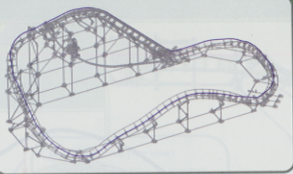
Coaster with spiral
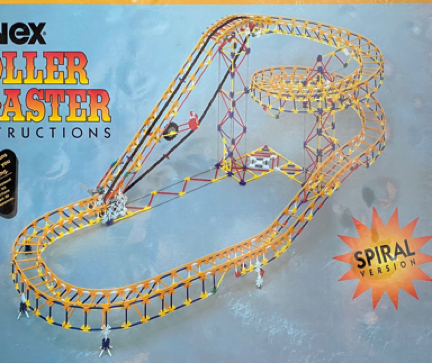
Ramps are great, but coaster take it to another level.
Why coasters?
Roller coasters have been around for over 100 years and they are still as popular as ever. Amusement parks all over the world are compete for riders thrills and money. But all coasters have one thing in common. The first hill on every coaster is the tallest hill on the ride. Why? Besides to build suspense for the upcoming drop!
If you study what is happening on that first hill, the coaster is being pulled up to the top of the hill by a strong motor and chain. But at the top of the hill the chain disengages and the coaster coasts down the hill and up, over and around the rest of the track. To coast around the entire track the coaster requires a lot of energy. The energy comes from the work the motor does to pull the coaster cars to the top of the hill. The motor received its energy from either electricity or gasoline depending on its type. At the top of the hill this work from the motor has been transformed into an increase in the coaster car's potential energy. Energy which is stored and can be used later. It comes from the object's height from the ground. As the cars move downhill, the energy becomes kinetic (motion) energy.
Of course, the ride is not all downhill. As the coaster glides over the hills and through the loops, the energy converts back and forth between kinetic energy and potential energy. A coaster can never go as high (or as fast) as it does on the first hill, because of friction between the wheels and the steel track. This friction robs some of the coaster's kinetic energy and transforms it into heat. Since no additional energy is given to the coaster, the loss of kinetic energy prevents the coaster from climbing any other equally tall hill. This is an example of one of the greatest generalizations in science, the law of conservation of energy, which states: Energy cannot be created or destroyed; it may be transformed from one form into another, but the total amount of energy never changes.
Therefore at any point of the ride, if you totaled the potential, kinetic, heat, and sound energy (plus any energy you, the track, or the air may absorb) their total would equal the original amount of energy the coaster had at the top of the first hill. As the coaster goes down the first hill some of its energy is transformed into other forms which leaves less kinetic energy available to get it up the next hill. So the next hill must be smaller than the first or the coaster will not go over it.
Focus questions
- How can we use science (STEAM) to investigate roller coaster?
- How are ramps, coasters, or ball runs designed?
- How do we cooperate to build, operate, and learn about motion and forces on ramps, coasters, and ball runs.
- How does science inquiry develop understanding?
- How does the motion of objects change going down a ramp?
- What is a Roller Coaster or ball run?
- What kind of motion do objects on them have?
- How does the energy of a coaster change from start to end?
- How is energy transfered down a ramp, on a coaster, or a ball run?
- What affect does the motion have on the different sensations you feel on a roller coaster? see below
Procedure
Select a focus question or two for big ideas to investigate. Decide on what kind of system to use to explore and investigate. Review information below to plan and write a sequence for an investigation. What to explore and how, data to collect from the exploration, and questioning strategy to answer more specific questions to invent scientific concepts and to apply them to more investigations and explain what is happening and why.
Planning information by categories ...
Energy - potential and kinetic
Energy is a tough concept to understand and explain because the only time it can really be seen, felt, or heard is when it is being transferred from one form to another or being transported from one place to another. For us to concretely observe the effects of energy, something has to happen. Ramps, ball runs, and coasters can be used to illustrate and help learners discover the concept of energy.
Background information
Energy is defined as the ability to do work. And work is the ability to apply a force (push or pull) over a distance. (A fourth grader accurately defines energy as: something that makes things move. An underlying functioning of every coaster is a basic law of physics: the law of conservation of energy. This fundamental law of physics has nothing to do with saving energy but what happens to energy when it is used. The law states that energy cannot be created or destroyed; it may be transformed from one form to another, but the total amount of energy never changes.
The learners energy is used to do work on the vehicle or sphere when it is placed at its starting point on the track. The energy is not lost, but transferred to the vehicle. The vehicle now has a higher energy level due to its higher position off the floor. This is called potential energy. The higher it is raised, or the heavier it is, the higher its potential energy. When it is released, the potential energy transforms into energy of motion or kinetic energy. At no time can it have more kinetic energy than its original amount of potential energy. Throughout the coaster ride it experiences a continual interchange of potential and kinetic energy as it rolls over the hills and through loops. But at no time will the combination of the two be greater than the initial amount of potential energy at the starting height of a ramp or starting hill if the coaster is lifted from a starting point to the top of the initial hill.
Focus questions
- What did you do to start the run and assure it completed it?
- Describe changes made to the track and why they were made.
- Make a scaled diagram of the final track from 3 views: above, front, and side views.
- Share the models and the diagrams and explain modifications you made.
- If you change the initial and final elevations, explain why they were changed.
- What determines the release point? It has to be high enough to get it over the first hill.
- What is potential energy? Potential energy is the name given to the energy of an object due to its position.
- Which has more potential energy: a vehicle held at the start point or a vehicle when it is a top of the first hill? depends on the track. If the vehicle is towed up the first hill, then at the top of the first hill. If the starting point is at the top of a ramp, the starting point.
- How would you increase the potential energy? Raise it higher.
- Where on the track is the potential energy lowest? Lowest point/bottom of hills
- Where on the track does the vehicle move fastest? Lowest point/bottom of hills)
- What is kinetic energy? Kinetic energy is the name given to the energy of motion.
- What happens to potential energy and kinetic energy as the ball goes down a hill? Going down the hill, potential energy changes to kinetic energy.
- What happens to kinetic and potential energy as the ball goes up the next hill? Kinetic energy changes to potential energy.
- If the ball stops while going up the hill, is there kinetic energy?No. No motion. OR Yes, heat is kinetic energy at the atomic level.
- How does the potential energy at any point, beside the start, compare with the original potential energy?It must be lower, because the height is lower.
- Has energy been lost?or is some energy missing? It was transferred to friction. It was converted to heat energy because of friction. Some of the kinetic energy was transferred to molecules in the track, ball, and air.
- What does it mean to say energy is conserved? Energy is conserved or transfered from one form to another. Energy changes forms, but it’s never lost. If the energy conversions could be complete, the initial and final elevations could be the same. However, the final elevation is less than the original, because some energy will be converted to heat via friction.
- Describe how potential and kinetic energy changes as a vehicle moves around the track. The beginning position is linked to potential energy. Potential energy is converted to kinetic energy (energy of motion) during the drop. During the subsequent rise, kinetic energy is converted back to potential energy.
Coaster energy challenge
Review the diagram and answer the questions about the energy at different positions.
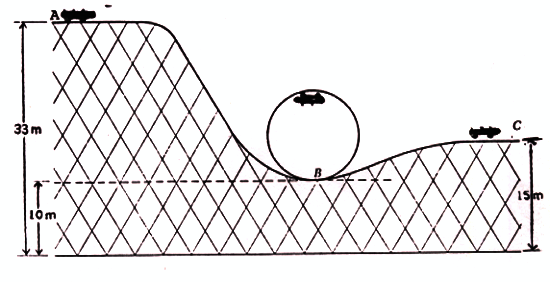
- How does the potential energy of the car on the roller coaster at position
- A compare to that at B?
- B compare to position C?
- What affect does the loop have on
- the potential energy of the car?
- Its kinetic energy?
- How does the kinetic energy of the car at postion
- A compare to B?
- B compare to position C?
Place an X on the point where the kinetic energy is the greatest.
Identify where the kinetic energy is the lowest.
- If the car's weight were decreased by a large amount, how would the potential energy, kinetic energy and the distance of run be affected?
- If the car's position were increased to a height of 40 meters, how would the potential energy, kinetic energy and distance of run be affected?
Motion, curves, forces & Newton’s laws
- What do you feel when riding a roller coaster that you might not feel in a car going the same speed? Feelings of weightlessness, heaviness, sliding around on the seat, feeling of flying out when rounding a curve
- What properties
of the track are related to these sensations?Weightlessness at
top of a loop or when going downhill; heaviness or push back into seat when going up a hill at high
speed; sliding around or flying out when rounding a curve.
- The effects felt during a roller coaster ride are the result of forces acting on the car (and on passengers).
- A feeling of weightlessness is produced during moments that we (and the objects touching us) experience free fall.
- This might happen at the top at the top of a loop, where gravity might be the only force acting on us.
- A feeling of heaviness is produced when the force pressing up on us is greater than the force of gravity.
- Heaviness is most pronounced at the bottom of a curve.
- The force that produces circular motion (centripetal force) pushes or pulls toward the center of the circle. At the top of a curve, centripetal force is provided, at least in part, by gravity.
- At the bottom of a curve, centripetal force is provided by the ground/track pushing up in reaction to the amount that we press down.
- What is the shape of the track at these points? Curved
Newton’s first law says that an object in motion will keep moving at the same speed in the same direction unless a force is applied.
- When a roller coaster car goes around and over curves. What forces are acting on the car? forward motion, momentum, speed, gravity, track pushing up
- What makes it speed up and slow down? Gravity
- What keeps it moving along curves instead of going in a straight line?The track pressing up on the car; the track on a curve pressing in on the car.
- What has to be done to a horizontal curve to make the car or sphere stay on the track?Banking
- What direction would the marble go if there was no bank or friction? Straight
- This is what Newton called his ... ? Newton’s first law of motion
So according to Newton’s first law, if direction changes there needs to be a force.
- What is the direction of the force? To the center of the circle
- The car is pushing on or exerting a force on the track. What is the direction of that force if the track isn’t banked? Downward
- If the track is banked, some of the force from the car is in a sideways direction. So where do we get a force that points inward? The banked track pushes back.
Newton’s third law is, for every force there is an equal and opposite force. Or, if a force acts on an object, the object also exerts a force.
- If the car is pushing on the track, what is the opposite and equal force? The track pushes on the car. Partly upward, partly to the center of the circle.
- How does the track need to be shaped so cars or spheres don't fly off? The track has to be arranged so it can exert a force back toward the center of the entire track.
Vertical curves.
- What variable is most important for keeping the car on the track when there’s a vertical loop?Speed
- What direction is the force that keeps the marble moving on the loop?What direction would the marble go if there wasn’t such a force? (To the middle of the circle)
- What forces change the direction of a vehicle so it keeps moving in a curve? Track, gravity. If someone answers, centripetal, ask, what is making the centripetal force?
- The track directs a force to the center of the circle. At some points gravity also gives at least some of its force toward the center of the circle. Where on the loop is there probably the least force between car and track? Top
- What happens in a loop? At the top of the loop, gravity takes over. So for a moment the car and it’s passengers experience something close to free fall or weightlessness.
- What would happen with a smaller loop or a tighter curve or higher hill or more hills?
- What would happen with vehicles of different weight?
Science process and perspectives
- Discuss the relationship of inquiry to the design/testing process.
- Discuss the difference in the inquiry that might be done with more investigation.
- What is the relationship between the science inquiry and design?
- What other forms of inquiry would be possible/appropriate? (Ethnographic and Experimental)
References